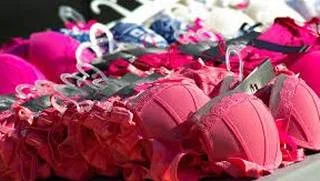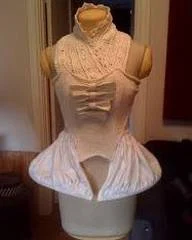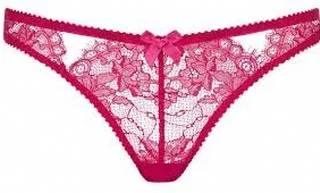Introduction
The
word lingerie was taken directly from the French language that means inner-wear
or undergarments. It was used exclusively worldwide for more lightweight items
of women's undergarments. Informal use offers eye-catching or even, erotic
attire.
What is lingerie?
Lingerie
is a category of women’s clothing that includes underwear basically brassieres,
sleepwear, and lightweight robes. The specific choice of words often implies
that the dress is alluring, fashionable, or both. In a 2015 U.S. survey, 75% of
women and 26% of men reported wearing sexy lingerie in their lifetime. Lingerie
is lightweight, stretched, smooth, perfect, or decorative fabrics such as silk,
satin, lycra, charmeuse, chiffon, or especially lace. These fabrics can be made
with natural fibers like silk or cotton or synthetic fibers like polyester or
nylon. There are various
types of lingerie, like bralettes, thongs, G-strings, knickers, girdles, tanga,
bustiers, bodysuits, camisoles, slip dresses, teddies, corsets, chemises,
negligees, babydolls, nightgowns, petticoats, hot & sexy hosiery, garter
belts, bodystockings, etc.
History of lingerie
The
concept of lingerie is an eye-catching undergarment that developed in the late
nineteenth century. Lady Duff-Gordon of Lucille was a pioneer in the
development of lingerie that freed women from a more controlled corset. In the
first half of the twentieth century, women wore lingerie for three primary
reasons: to change their appearance, for health reasons, and modesty. Before
the discovery of crinoline, women's lingerie was often very large and bulky.
As
the twentieth century progressed, underwear became smaller and more
form-fitting. In the 1960s, lingerie manufacturers like Frederick of Hollywood
began to glamorous lingerie. The underwear industry expanded in the
twenty-first century with designs that doubled the outerwear. The French refer
to it as 'Dessous-Dessous', which means similar to underwear as outerwear.
The
lingerie market at the beginning of the 21st century was driven by the advent
of modern technology and fabrics that helped design innovative products like
laser-cut non-stop bras and molded T-shirt bras. Designers are emphasizing a rich
look at fabrics, lace, embroidery, and bright colors.
Types of lingerie
There are different types of lingerie we found, such as below-
1. Babydoll
A babydoll is a type of lingerie, short, sleeveless, loose-fitting nightgown or skirt, aimed at nightwear for women. It sometimes forms a cup called a bralette for cleavage with an attached, loose-fitting skirt that falls in length between the belly button and the upper thigh. The dress is often trimmed with lace, ruffles, appliques, marabou, bows, and ribbons, optionally with spaghetti straps. Sometimes it is made of translucent fabric like nylon or chiffon or silk.
2. Basque
A
basque is a type of lingerie for women's clothing. The term is of French descent, referring
to the type of long-tailed bodice or jacket, and for later use extends the
waistline with a long corset, a close-fitting fit, and hips. This is so-called
because the original French fashion for long women's jackets was adopted from
the Basque traditional themed dress. In contemporary use, it simply refers to a
long item of lingerie, resulting in a bra that continues at the bottom, closing
at the top of the waist or hips, the bottom part being largely decorated rather
than providing support or actual warmth.
3. Bodystocking
A bodystocking is a piece of skin-tight clothing that covers the torso, legs, and sometimes the arms. It is an article of foundation clothing or lingerie that is usually made from sheer fabric used for stockings or pantyhose, or from fishnet, lace, or an opaque material or a variant of these materials. Unlike a bodystocking unit, which is worn as a costume or article, and a leopard, which is used as a practicing costume or performance costume for acrobats, gymnasts, and other similar actors. Designed to be published, but not too revealing, body stockings can be worn as underwear by belly dancers and exotic dancers.
4. Bodice
A bodice is a type of lingerie for women's and girls' clothing that covers the body from neck to waist. The term usually refers to the upper part of a modern garment to distinguish it from a certain type of common European clothing or skirts and sleeves during the 16th to 18th centuries. The word comes from a pair of bodies. To achieve a fashionable shape and to support the bust, the bodice was often tightened with bents or whalebone. The bodice was different from the corset of the time because it was intended to be worn over other clothing. In earlier times, the body and corsets were embroidered in a spiral fashion with a continuous lace. In the ensuing period, the two became involved like modern tennis shoes and came face to face. It was more convenient for women to wear clothes.
5. Brassiere
A
brassiere is a form-fitting underwear designed to support or cover the wearer's
breasts. The bra is designed to enhance the size of different layers, create
partitions, or for other aesthetic or practical considerations. Swimwear,
camisole, and backless dresses can have built-in breast support with supportive
bra cups. Nursing bras are designed to facilitate breastfeeding. Some people need
treatment and surgery for bras, but most wear them for fashion or cultural
reasons. There is no evidence that brass can prevent breasts from sagging, and
one study even suggests the opposite, without wearing them during sports
exercises.
6. Bustier
A bustier is traditionally form-fitting clothing as women's lingerie. Its primary
purpose is to gently shape the waist while tightening against the upper midriff
and forcing the breasts. Nowadays, it can also be worn as a camisole for
push-up bras or outerwear under low-backed clothing. If you don't like
Midriff's bold look, you can wear it as a half-slip under the perfect top
dress. A bustier is similar to a basque but it is shorter. It only reaches up
to the ribs or waist. Modern bustiers are often made from mesh panels rather
than boning.
7. G-string
A
G-string is a type of lingerie, a narrow piece of fabric, leather, or satin that
holds the genital covers, extends to the middle of the buttocks, and is
attached to a waistband around the hips. A G-string can be worn by both men and
women. It can also be worn after a swimsuit, where it may serve as a bikini
bottom but it can also be worn alone as a monokini or topless swimsuit.
G-strings can also be worn by foreign or go-go dancers. As for underwear, a
G-string panty can be worn in shorts to avoid the creation of the desired panty
line, or in shorts to increase sexual appeal. However, typically they refer to
different pieces of clothing.
8. Negligee
Negligee is a type of lingerie among women that
usually consists of long dressing gowns for free. This is a form of nightgown
intended to be worn at night for the bedroom. It was introduced in France in the
18th century, where it mimicked the heavy head to toe style of women’s daywear
at the time. In the 1920s, women of the negligee began to imitate satin
single-layer evening dresses. Although the evening dress style moved to the
modern negligee style that is translucent bodies, lace trimming, bows, which
were emulated by a 1941 picture. After World War II the nightwear became
primarily sensual or even romantic to be useful, negligee lingerie emerges
strongly as a form. Modern negligee is often made of many loose and sheer and
diaphanous fabrics and trimmed with lace or other delicate elements and bows.
9. Pantie
Panties
are types of lingerie that are primarily worn by women. It can be form-fitting
or loose. Common elements include an elastic waistband, a crotch panel to cover
the genitals, and a pair of legs that are often as elastic as the waistband.
Different materials are used but are usually chosen for breathing. The panties
are made of a variety of materials, including cotton, lace, latex, leather,
lycra, mesh, nylon, PVC, polyester, satin, and silk. The construction usually
consists of two pieces which are joined by seams on the crotch and side part.
Made with elastic at the waist and legs open, an extra gusset is often in the
crotch.
10. Thong
Thong is a type of lingerie that is commonly used as underwear or in some countries as swimwear. It can also be worn for conventional events or competitions. Seen from the front, the thing is usually similar to a bikini bottom, but at the back, the material is minimally reduced. Thongs are often made to cover the genitals, anus, and perineum, and to cover part or most of the buttocks. The back of the dress usually has a thin waistband and a thin stripe, designed to be worn between the buttocks, which is attached to the lower part of the dress in the middle of the waistband. In the context of "thong backed" it is also used as a descriptive term in other types of clothing such as bodysuit, bodystocking, leopard, or one-piece swimwear.


















0 Comments